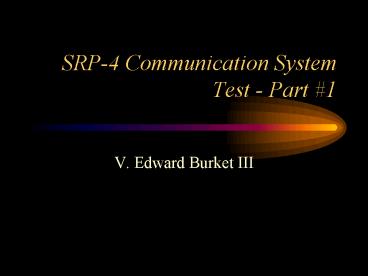SRP4 Communication System Test Part - PowerPoint PPT Presentation
1 / 16
Title:
SRP4 Communication System Test Part
Description:
signal strength output voltages that correspond to carrier power levels at the antenna flange ... generator simulates the input at the receive antenna flange. ... – PowerPoint PPT presentation
Number of Views:49
Avg rating:3.0/5.0
Title: SRP4 Communication System Test Part
1
SRP-4 Communication System Test - Part 1
- V. Edward Burket III
2
Purpose
- Part one of the communication system test
experimentally determines - the carrier power level necessary at the receive
antenna flange to obtain a clean demodulated
signal from the Microdyne receivers video
output. - signal strength output voltages that correspond
to carrier power levels at the antenna flange
3
Test Setup
IF BW 3300 KHZ VIDEO BW 500 KHZ
F 2.218 GHZ
MOD BW 3 MHZ
L 4.4 dB
HP8780A Signal Generator
Microdyne Receiver
50 ft. Low Loss Coax
P_out
FM mod.
Video Out
50 kHz 1Vp-p
Function Generator
O-Scope
Signal Strength Output Voltage
4
Comments on Test Setup
- The HP8780A signal generator simulates the input
at the receive antenna flange. - For the actual SRP-4 mission, a low noise
amplifier with a gain of 20 dB will be inserted
between the receive antenna flange and the coax
cable.
5
P_out vs. Signal Strength Output
6
P_out vs. Carrier Threshold
7
P_out vs. Video Signal Quality
8
Accounting for Noise
- In a communication system, noise power is
received in addition to the carrier power. - Since the signal generator is matched to the 50
ohm coax at the antenna flange point simulated in
the test, the total noise power at the flange is
- NikTB(1.3810-23 J/K)(290 K)(3300 KHz)
-138.8 dBW -108.8 dBm.
9
Minimum Carrier to Noise Ratio
- Since the input noise power at the simulated
antenna flange is -108.8 dBm, and the minimum
carrier input power that yields a clean
demodulated video signal output is -85 dBm,
the minimum input carrier to noise ratio is - -85 dBm - (-108.8 dBm) 23.8 dB.
10
Comparing Test Noise Power with Expected Noise
Power
- Under actual conditions, a maximum antenna noise
temperature of 300 K is expected for a total
input noise power of - Ni (1.3810-23 J/K)(300 K)(3300 kHz)
-138.6 dBW -108.6 dBm - This is virtually the same as the test input
noise power of -108.8 dBm.
11
SRP-4 Link Budget EIRP
- Transmitter Output Power, Pt 34 dBm
- Worst Case Transmitter Antenna Gain Gt
- 10 dB - EIRP Pt Gt 24 dBm
12
SRP-4 Link Budget Receive Antenna Gain and
Beamwidth
- Theoretical gain of 1.22 meter antenna with 0.55
efficiency and free-space wavelength of 13.5 cm
Gr 38.5 dB - Half-Power Beam Width (approximate)
- HPBW 7.75 degrees
- Pointing loss assumed for link budget
- L_p 3 dB
13
SRP-4 Link Budget Space Loss
- At apogee, assume x 30 km and y 92 km. Then
slant range 96.8 km and space loss at apogee - L_sa 138.7 dB
- On launch rail, assume x 1.6 km. Then space
loss on rail - L_sr 103. 5 dB
14
SRP-4 Link Budget at Apogee
15
SRP-4 Link Budget at Launch Rail
16
Conclusions
- The SRP-4 communication link has a margin of 4.8
dB at apogee. This margin will be improved with
the addition of the LNA. - Pointing the receive antenna directly at the
rocket while it is on the launch rail will not
overload the receiver front end.































